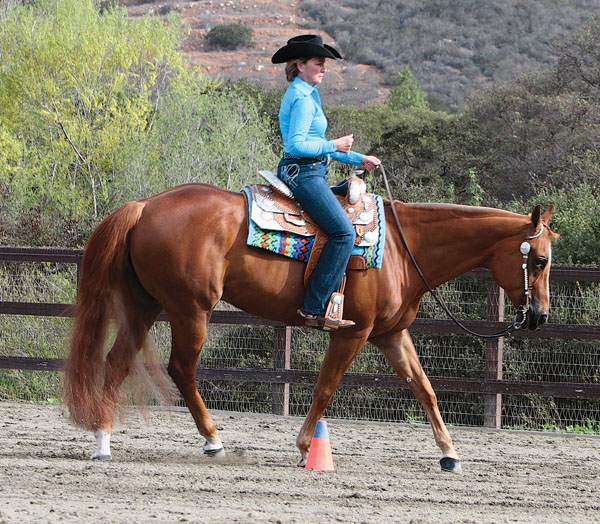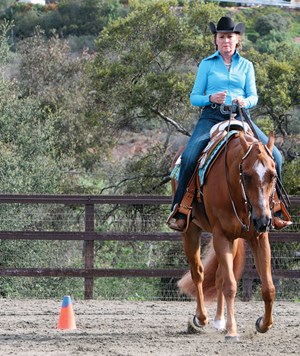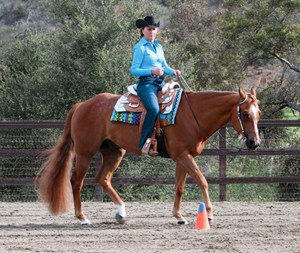Q In pattern classes, from ranch riding to horsemanship, I often see the judge call for square corners. It’s something that I’ve struggled with executing correctly. How can I make a good square corner?

Alicia Hughes, Illinois
A It’s great that you pay attention to how a pattern is drawn, because many riders don’t recognize that, when called for, a square corner is a required maneuver of that pattern—the judge put it there for a reason. Especially in horsemanship, a mandate for a square corner means make one like you would if you were drawing it on a piece of paper—crisp and precise. In a ranch riding pattern, it might not need to be quite as tight, but you still should make a visible, concerted effort to square the corner if it’s drawn that way on the pattern.
Even if you don’t compete, working on square corners at home can be a fun, challenging way to improve your horse’s handle, so it’s not just a “show skill,” but rather something that’s good for all riders to work on. Here, I’ll explain how a square corner should look, common mistakes (and how to fix them), and a few easy exercises to try at home. My tips are based on the horsemanship class, but you can apply them for ranch horse pleasure and general riding.
Perfect Square
A correct square corner has three portions: the approach, the execution, and the exit.

As you approach your designated spot to turn, your horse should have a lot of drive from behind and travel in a cadenced gait. Just before you get to the spot where you’ll turn, begin to turn your body, which changes your position in the saddle and gives your horse a heads-up about what you’re going to ask.
Once your horse’s shoulder reaches the marker, quietly move your hand to steer him through the corner. You want to use as little visible movement as possible, but of course at home you can use as much rein cue as necessary, toning it down as your horse gets more perceptive. This is where shifting your body position helps, because it assists in driving your horse along the path. For timing, you almost want to ride your horse past where you’ll turn and then make the cue.
When you exit the turn, you’ll need to accelerate, just a bit, to keep from breaking gait as you continue on your path. Use your legs and seat to drive your horse forward and onto the next maneuver. The crisper you are through the turn, the more points you’ll earn.
Common Pitfalls
If you struggle with square corners, it’s probably due to one or more of the following mistakes I see amateur and youth riders make.
Not turning your body. If you’ve taken lessons, your trainer probably has gotten on you at least once to look where you’re going. When executing a maneuver that’s as path-based as a square corner, you have to look ahead of where you’re going to prepare both yourself and your horse. If you’re looking down or to the other side of the arena or anywhere other than your path, you won’t achieve the correct timing required for this maneuver. By looking where you’re going, your eyes will signal your body to communicate the intended path to your horse. By turning your body slightly to follow your eyes’ path, you shift your weight to prepare your horse to make a corner.
Over-steering. Almost as bad as not paying attention (under-steering) is the opposite: steering too much. It’s essential that you get the timing right for steering through the corner and then straightening your horse, and timing comes with lots of practice. You need to drill a square corner quite a few times to determine what your horse needs, cuewise. The judge will deduct from your score if you get through the corner well, but then have to jig back and forth to get on the correct exit path.

Rounding the corner. Just about anyone can ride through a rounded corner without a lot of effort. The point of a square corner is to show off your skills and a higher degree of finesse in your horse’s steering. Lazily plowing around a corner won’t earn you points; in fact, it’ll cost you quite a few.
Exercises to Try
I recommend working on these drills at home, and then incorporating what you can in the competitive arena.
Draw a map. When practicing at home, set up a cone to designate where to make your corner. While you’re on the ground, “draw” your pathway in the dirt. Sometimes having a blatantly designated path will help you get on track and identify areas in which you struggle. Note along your route any place that your horse gets particularly pushy or hard to steer. Pay attention to your own timing—are you too quick or too slow to cue for the turn? And don’t look down! Glance through the bottom of your eyes if you must, but remember that your eyes will help lead your body to turn in the saddle.
Use your legs. Subtle leg cues are much harder for a judge to see than are rein cues, so practice using more leg than hand when drilling square corners. Experiment with how much outside leg your horse requires to keep his impulsion. Determine if he might benefit from a spur to keep him from leaning or breaking gait.
Practice at all gaits. More than likely, it’ll be harder for your horse to execute a corner at one gait or another, and possibly in one direction. Determine that at home, and then really work on his weakness to build both of your confidence when it comes time to compete.
Jill Newcomb, San Marcos, California, is a lifelong horsewoman and an AQHA judge. She specializes in all-around events and has successfully coached and shown world champions and All American Quarter Horse Congress winners. Learn more about Newcomb’s program at jillnewcomb.com.






